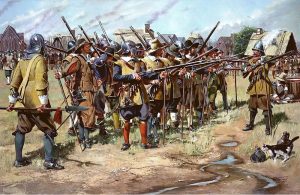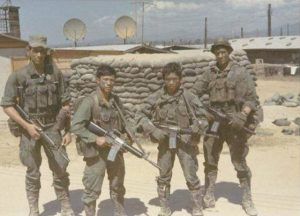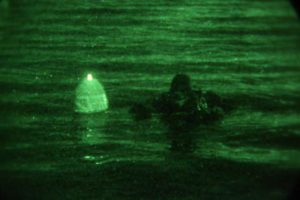“Military Stuff” is a wide, deep, and vast canyon of a subject. Most people – even within established militaries – try to impart as deep a knowledge of military items and terms to their troops – not only about their own items but also about as many foreign weapons as they can realistically report on – as quickly as possible. This is, however, frequently a spotty and haphazard process, and seldom takes a firm hold in memory for any but the most commonly-used items and terms.
This is a much greater problem when civilians, or even military veterans, try to catch up on short notice because of “Situation X” has happened “suddenly”, and people watching the TV or news websites have no idea of the terminology being casually thrown around by professional presenters — who are also largely clueless about the terms they just dropped…
…And sometimes, when people who certainly know better, blatantly lie for political purposes:
The results are misleading and frustrating, to say nothing of alarming and potentially very damaging, as people who may not trust their government or news agencies very much, don’t know how to make sound judgements based upon what they are seeing.
As a result, we need to correct some mistakes of terminology. This should not be understood as pointless doting, as confused terminology results in all of the evils above. This will almost certainly not be a complete list, and we will likely make this into a multi-part series.
With that out of the way — let’s get started.
RPG, LAWS or AT-4?


“RPG” is a generic term for a man-portable, rocket-propelled grenade launcher.
This can cover a wide variety of weapons, but it is also the specific designation of a Soviet-designed weapon of extraordinary utility and longevity: the legendary RPG-7 series. To avoid confusion, the term “RPG-7” should be used only when referring to that specific weapon.


In contrast, the US-designed M72 “LAWS” and the Swedish-designed “AT-4” weapons,
and their many foreign copies or equivalents, are also RPG-like devices, and perform similar functions.
“Rifle” vs. “Gun”
A rifle is not a gun, and a gun is not a rifle.

A ‘rifle’ is a small arm designed to be carried and fired by one

person.
“Rifling” is a descriptive term denoting the spiral grooves cut into a barrel to impart centrifugal spin to a projectile, increasing accuracy.
A ‘gun’ is a very large, “crew-served” weapon, sometimes also called a ‘cannon’, which fires a very large (1 inch+ diameter) projectile, usually explosive-filled. Guns are either towed like a trailer behind a vehicle, or are mounted on vehicles in their own right.

Magazine, Clip and Charger
These are NOT the same things!
In infantry parlance, a “magazine” is a detachable box containing a number of cartridges [q.v.] under spring tension, used as a component to the rifle’s feed system. Outside of the infantry spectrum, it can refer to both a storage facility for land and naval artillery ammunition, and as an archaic term for a general supply depot.
A “clip” is a small piece of sheet metal that holds a fixed number of cartridges in the fixed, internal magazine of a weapon.
A “charger” is a small piece of sheet metal holding a fixed number of cartridges for loading into an internal magazine by being manually pushed off of the charger.
EXAMPLES:





Bullet vs. Cartridge vs. Round

A “round” is a complete projectile/propellant/case combination containing both projectile and propellant in a metal case.
A “bullet” (or “shell” if filled with explosives) is the projectile fired by any weapon that leaves the barrel at the muzzle.
A “cartridge” is a container used to hold bullets and propellants firmly in a more or less watertight environment.
Tank vs. APC vs. “Armored Car”
This is one of the single most misunderstood terminology conflicts out there, and is one of the most important conflicts to resolve.

A “tank” is a large, heavily armored combat vehicle, capable of carrying and firing an artillery-grade weapon, usually from a rotating turret. Although there are several classes of tank (light, medium, heavy and assault), and some tanks are designed without turrets, the cue is the massive cannon they carry.

In contrast, while an APC (Armored Personnel Carrier) may resemble a tank in many respects, it is most certainly not a tank. One of the earliest APC’s, the M113, have been made in such numbers (well in excess of 80,000, and remained in production from 1960 to 2014, although parts are still made in many countries), it is the “gold standard” for the class.
APC’s, or “Armored Personnel Carriers,” are used to transport infantry troops to support and protect tanks. APC’s are usually very lightly armored, compared to tanks, and usually do not possess weapons that can engage tanks successfully, although some do carry one or two anti-tank guided missile launchers. Note that APC’s and armored cars do sometimes have turrets, and relatively heavy guns; this does not make them tanks, due to their extremely thin armor (compared to that of tanks).

Closely related to the APC (and developed from it), is the “Infantry Fighting Vehicle”, or IFV. This vehicle class is largely responsible for all the confusion regarding the differences between tanks and everything else. IFV’s tend to carry small infantry units, but are also armed with significantly heavier weaponry than APC’s. The Soviet-designed BMP-1 was the first IFV ever designed, and still soldiers on, all over the world.


An “armored car” is just that: essentially a large truck or “Sport Utility Vehicle” (SUV)
that has been plated in armor of some kind to make it proof (more or less) against rifle/machine-gun fire and artillery shrapnel. These vehicles are correctly employed only for security and convoy escorts, where their opponents will mainly be light infantry, who are very susceptible to the armored cars’ onboard machineguns.
“Rifle” vs. “Machinegun”
There is great confusion engendered by a heavily-politicized media establishment, either by incompetence or design, over small arms types. As described above, a ‘rifle’ is a small arm, intended to be carried and fired by one person.

In contrast, a machine-gun is a sustained-fire (meaning that it is intended to fire in automatic mode [q.v.] for extended periods), crew-served (meaning that it requires more than one person to operate) weapon intended to support infantry units.
Although some rifles may fire like machine guns, they are simply rifles with an automatic-fire function.
“Automatic” vs. “Semi-automatic” vs. “Selective Fire” vs. “Runaway Fire”
“Automatic” means that once the trigger is pulled, a weapon will continue to fire until either the trigger is released, or the weapon runs out of ammunition.
“Semi-automatic” means that when the trigger is pulled and the weapon fires, the weapon cycles the next round into the chamber with no input from the shooter, who must pull the trigger again to fire.
“Selective fire” means that a rifle can be easily transitioned back and forth between Automatic and Semi-Automatic by the operator.
A “runaway” is what happens when something goes wrong inside a semi-automatic firearm, and it begins firing in a fully-automatic state until it runs out of ammunition. This is the result of either operator error (for example, if the weapon is reassembled improperly), or parts breakage. All shooters dread a runaway condition, because it is unexpected, and very hard to control.
Cover vs. Concealment
“Cover” (as in “taking cover“) refers to any material or structure that can act as a shield or stop against direct small arms fires and light, hand grenade-sized fragments. Some structures, commonly called “bunkers“, are built to withstand fire from artillery shells and missiles.
“Concealment” refers to any material or structure that will conceal, or hide, the unit from observation by the enemy. Concealment typically offers little to no cover or protection.
Finally, there are a truly vast number of free resources online for anyone wanting to learn about the “nuts and bolts” of military systems. While a site like Wikipedia is fine – as long as one knows how to use it – it has a significant number of errors; the Freedomist doesn’t use Wikipedia because it is necessarily accurate, but because it is a fast and clean interface. Nothing at Wikipedia should be taken wholly at face value – it is a starting point, nothing more.
Other “clearing house” sites – such as MilitaryFactory, or Gary’s Olive Drab Page – are also fine, more or less, but in addition to having some accuracy issues, a user has to have a rather specific idea of what they are looking for. Below, are some free resource sites with good generalized pages…
Federation of American Scientists (FAS): The FAS does have a currently functioning and updated website, but they no longer update the pages listed below. These older pages are deliberately kept online – albeit with no further updating – because they do provide solid information to the general public about military affairs. The following links are specifically for “Land Systems” (military equipment used on land), and is very comprehensive. These links cover all sorts of vehicles and weapons, and is one of the best sites to scroll through if you are looking for something you don’t recognize; once you find it, you can use the FAS data to search Google for more information…
US Land Warfare System
“Rest of the World” Land Systems
“Older” Land Systems
A “clearing house” site, Olive Drab has one of the most extensive libraries of entries on military equipment, albeit primarily US equipment. It is listed here, because it is so in-depth of a resource, its entries are frequently used by Wikipedia…
Finally, we come to the ODIN “World Equipment Guide”. This is the official – and unclassified – site that the US Army uses as a training resource. In addition to multiple wargaming environments, ODIN maintains a series of databases that cover non-US military equipment, including data on improvised combat vehicles, such as Technicals…
To paraphrase Christopher Hitchens, You may not be interested in war – but War is definitely interested in YOU.
To quote someone far more educated and experienced than Hitchens: “Sun Tzu said: War is a matter of vital importance to the State; the province of life or death; the road to survival or ruin. It is mandatory that it be thoroughly studied.” (The first line in Sun Tzu’s ‘Art of War’, c.500BC)
These things are paid for – both in cash, as well as in blood – by you, the Reader. You need to learn this stuff, whether or not you are carrying a rifle or making decisions about sending someone else’s children out to go and do these things.








